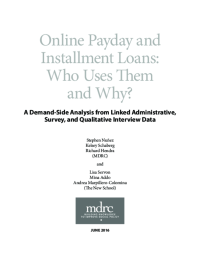Online Payday and Installment Loans
Who Uses Them and Why?

This paper, funded by MetLife Foundation, explores the use of an increasingly important and controversial component of the consumer financial system in America: online subprime small-dollar credit (also referred to as “payday lending”), which is banned or heavily regulated in several states but is legal or only somewhat restricted in others. The paper uses an unusual combination of data sources — administrative data provided by subprime lenders combined with survey and in-depth interview data obtained from borrowers — to gain a better understanding of the range of backgrounds and experiences of people who use these loans and the needs that drive borrowing.
The research team was given access to an administrative data set provided by Clarity Services, Inc., which has lender-reported data on nearly 50 million individuals nationwide who have applied for or used subprime credit from hundreds of lenders operating in all 50 states. This reach results in an unusually large-scale data set, which covers borrower characteristics and loan outcomes on a national scale. While the file that Clarity shared with the research team contained over 8 million loan records for 3 million borrowers, the analysis focuses on two smaller samples of individuals who received loans in 2014. The full sample includes 881,512 borrowers and is used to analyze how borrowing varies by geographic location. The analysis sample includes 198,499 individuals and contains higher-quality loan repayment data.
In addition to looking at borrowers overall, this paper examines the variation in borrowers’ circumstances by dividing them into user segments. Analyses of administrative, survey, and interview data revealed a great deal about the characteristics of this population and the “demand side” of small-dollar credit markets. In providing a rich description of the market, this research provides a basis for exploring potential avenues to improve outcomes among various segments of this population and for addressing the inherent challenges in developing effective strategies.
A second phase of this project, beginning in fall 2016, will extend the analysis of borrower behavior over time. Using an event history framework, the research will explore the origins of financial hardship and the differences in product use and outcomes before and after regulatory or policy change and across state lines.






